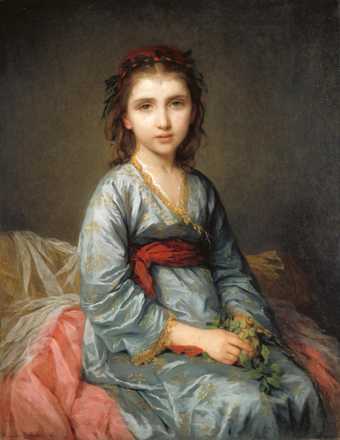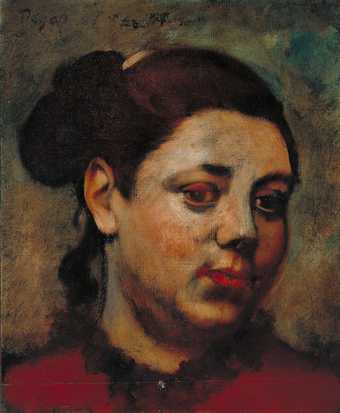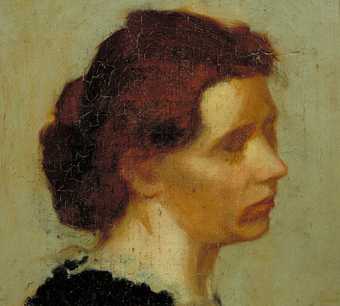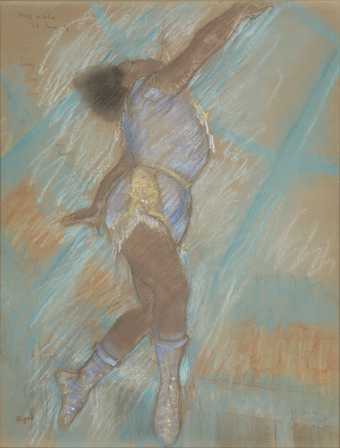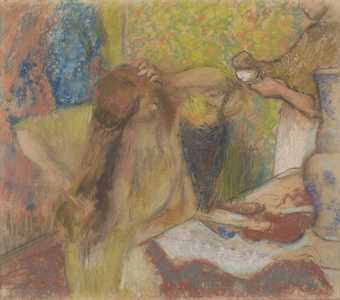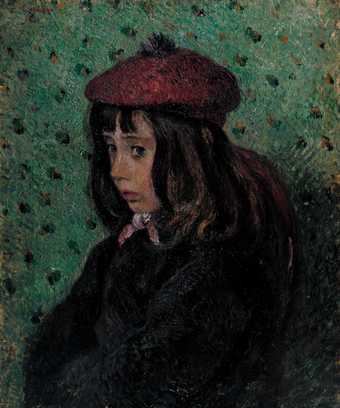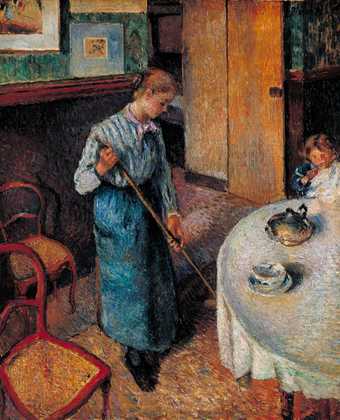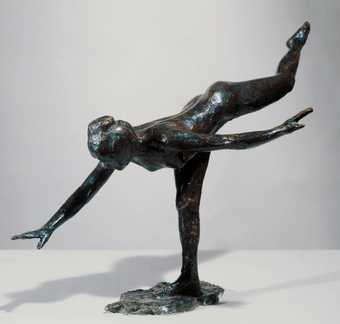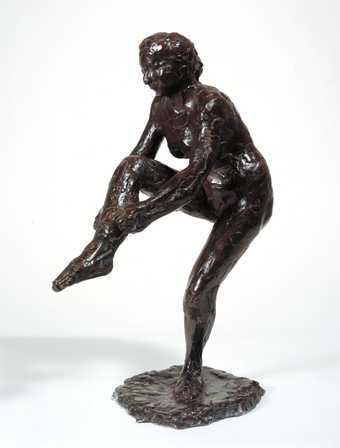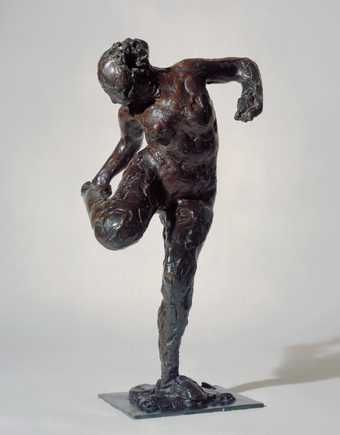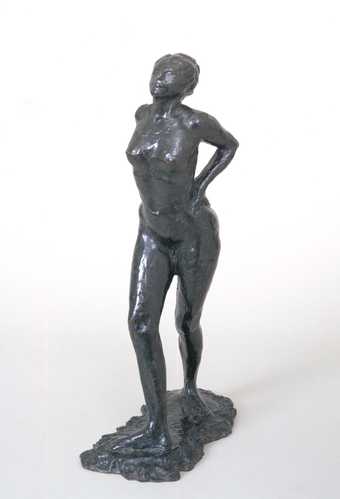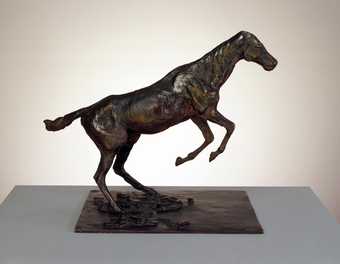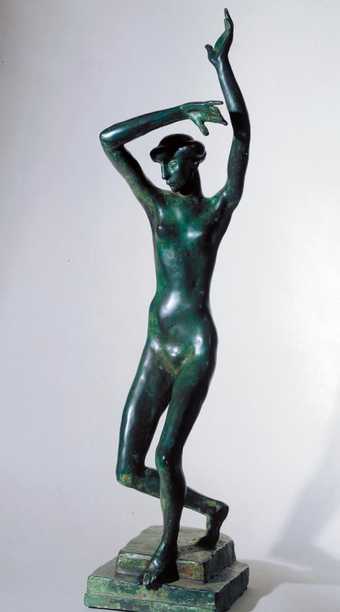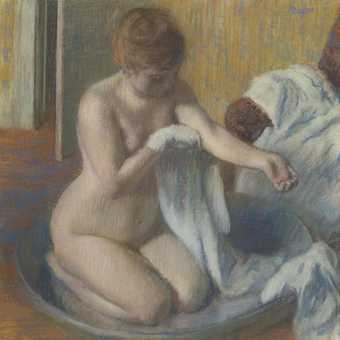
Not on display
- Artist
- Edgar Degas 1834–1917
- Original title
- Petite danseuse de quatorze ans
- Medium
- Painted bronze with muslin and silk on wooden base
- Dimensions
- Object: 984 × 419 × 365 mm, 31 kg (integral base included)
- Collection
- Tate
- Acquisition
- Purchased with assistance from the Art Fund 1952
- Reference
- N06076
Display caption
The model for this sculpture was ballet student Marie Van Goethem. Degas first made a wax sculpture of her in the nude. Then, aiming for a naturalistic effect, he dressed it in clothing made of real fabrics. When the wax sculpture was first exhibited, contemporaries were shocked by the unprecedented realism of the piece. But they were also moved by the work’s representation of the pain and stress of ballet training endured by a barely adolescent girl. After Degas’ death, his heirs decided to make bronze casts of the wax original.
N06076
Gallery label, March 2019
Does this text contain inaccurate information or language that you feel we should improve or change? We would like to hear from you.
Catalogue entry
Edgar Degas 1834-1917
N06076 Petite Danseuse de Quatorze Ans (Little Dancer aged Fourteen) 1880-1
Inscribed with founder's stamp 'CIRE | PERDUE | A.A. HÉBRARD' on outside of the left thigh, and 'Degas' and founder's stamp 'CIRE | PERDUE | A.A. HÉBRARD' on upper surface of base
Bronze, with muslin skirt and satin hair-ribbon, 38 3/4 x 16 1/2 x 14 3/8 (98.5 x 42 x 37.5) on wooden base
Purchased from Puvis de Chavannes through Marlborough Fine Art (Grant-in-Aid) with the aid of a contribution of £6000 from the NACF 1952
Prov:
Puvis de Chavannes, Paris (son-in-law of Mme Hébrard)
Exh:
The Complete Collection of Degas Bronzes, Marlborough Fine Art, London, December 1951 (20, repr.)
Lit:
Paul Mantz, 'Exposition des Oeuvres des Artistes Indépendants' in Le Temps, 23 April 1881, p.3; J.-K. Huysmans, L'Art Moderne (Paris 1883), pp.226-31; P.-A. Lemoisne, Degas
(Paris n.d.), pp.91-2; Paul Gsell, 'Edgar Degas, Statuaire' in La Renaissance de l'Art Français, I, 1918, pp.374-6, wax repr. p.375; Paul Lafond, Degas
(Paris 1918-19), Vol.2, pp.64-6; Paul-André Lemoisne, 'Les Statuettes de Degas' in Art et Décoration, XXXVI, 1919, pp.111-13, wax repr. p.112; Anon., 'La Danseuse de Degas' in L'Art et les Artistes, VI (N.S.), 1923, pp.158-9; Julius Meier-Graefe, Degas
(London 1923), p.60 and footnote; Paul Jamot, Degas
(Paris 1924), pp.113, 149, wax repr. pl.52; Lionello Venturi, Les Archives de l'Impressionnisme (Paris-New York 1939), Vol.2, p.138; John Rewald, Degas: Works in Sculpture (New York 1944), No.XX, pp.6-8, 14-15, 21, repr. pp.63-9; Lillian Browse, Degas Dancers (London 1949), p.370, repr. pls. 96-7; John Rewald, Degas: Sculpture (London 1957), No.XX, pp.16-20, 144-5, repr. pls.24-9; Charles W. Millard, The Sculpture of Edgar Degas (Princeton 1976), pp.5, 8-9, 14, 15, 23-4, 27-9, 31-2, 34-5, 38-9, 45, 60-5, 76, 80-3, 92, 98-100, 102, 108, 119-26, wax repr. pls.26 and 28 (detail), and colour pl. facing p.62
Repr:
John Rothenstein, The Tate Gallery (London 1958), pl. 8; The Tate Gallery (London 1969), p.97
The model for this sculpture was a girl named Marie Van Goethen, who was a pupil in the ballet class at the Opéra. As Charles W. Millard has pointed out, her identity is established by a drawing in the Louvre clearly done as a study for the sculpture which is annotated at the top, in the artist's hand, '36 rue de Douai Marie', coupled with the fact that Degas' notebook 2 (Reff 1880-1884) contains the address 'Marie Van Gutten 36 rue de Douai'. Marie Van Goethen (as her correct name seems to have been) was born in Paris on 17 February 1864, the daughter of a Belgian couple who were tailor and laundress. She was one of three sisters, all of whom were ballet students at the Opéra, and all of whom seem to have modelled for Degas.
Degas began by making a series of drawings of her both nude and dressed, and by modelling a study of her in the nude (Rewald No.XIX). The original wax not only had a gauze tutu, but a ribbed-silk bodice, pinkish ballet slippers and a wig, probably of horsehair, all of which were covered with a thin coating of wax. In addition, the figure was tinted to enhance the illusion of life. Though a wax statuette of this title was listed in the catalogue of the fifth Impressionist exhibition in April 1880, it was not exhibited there and it is unclear whether the work Degas intended to show was the nude study or the final, dressed version. The final work was subsequently exhibited the following year at the sixth Impressionist exhibition in April-May 1881 (arriving several days after the exhibition opened), when its very unusual character aroused much astonishment. It was the only one of Degas' sculptures exhibited in his lifetime, and was displayed in a glass case.
Marie Van Goethen was fourteen on 17 February 1878, so Degas must have started on the nude version some time after that date and probably continued working on it at intervals throughout 1879. The dressed figure was apparently begun either towards the end of 1879 or, more probably, in the spring of 1880, after Degas decided not to exhibit the nude version at the fifth Impressionist exhibition, and he seems to have added the finishing touches to it at the beginning of April 1881, during the first days of the following exhibition.
Though the casting of the other waxes was begun in 1919, the first bronze cast of this work was not made until late 1922 (cf. L'Art et les Artistes, January 1923, p.158), owing to the great technical difficulties involved. Indeed, until 1920 it was uncertain whether the piece would be cast at all or sold separately. With the exception of 'Woman walking in the Street', which for some reason was only cast at the time in an edition of two, the other 72 surviving sculptures were all cast by Hébrard on behalf of the Degas heirs in an edition of twenty-two, twenty for sale and one each for Hébrard and the heirs, plus a bronze master cast, making a total of twenty-three. Each cast is incised with an Arabic number from 1 to 72 identifying the sculpture, and the twenty sets for sale are also marked with a letter from A to T. The casts of the 'Little Dancer aged Fourteen' are not numbered and were thought for many years to have been cast in a smaller edition. However it now seems that there is probably the full number in existence, and some, if not all, of those made for sale are said by Charles W. Millard to be marked with a letter either on the wooden base or on the left thigh under the skirt 40.7 cm from the base. The Tate's cast does not appear to have a letter (unless one reads an irregularity in the bronze surface of the thigh as an embossed 'C'), but this may be because it is one of those that came from the Hébrard family.
According to Lafond the cracks below the left shoulder and at the right wrist were caused by the arms of the wax falling off, but it seems more likely that they were due simply to shrinkage of the wax. The bronze casts were dressed after the original with a tutu by Degas' niece Jeanne Fèvre.
The original waxes of this and all the Tate's other sculptures by Degas now belong to Mr and Mrs Paul Mellon in Washington, DC.
Published in:
Ronald Alley, Catalogue of the Tate Gallery's Collection of Modern Art other than Works by British Artists, Tate Gallery and Sotheby Parke-Bernet, London 1981, pp.148-50, reproduced p.148
Explore
- objects(23,571)
-
- clothing and personal items(5,879)
- actions: postures and motions(9,111)
-
- standing(3,106)
- girl(1,079)
- individuals: female(1,698)
- arts and entertainment(7,210)
-
- dancer(154)
You might like
-
William Robert Colton The Girdle
1898 -
Henriette Browne A Greek Captive
1863 -
Edgar Degas Head of a Woman
c.1874 -
Edgar Degas Head of a Woman
c.1873 -
Edgar Degas Miss Lala at the Cirque Fernando
1879 -
Edgar Degas Woman at her Toilet
c.1894 -
Camille Pissarro Portrait of Felix Pissarro
1881 -
Camille Pissarro The Little Country Maid
1882 -
Edgar Degas Grande Arabesque
c.1885–90, posthumous cast -
Edgar Degas Dancer Putting on her Stocking
c.1900, posthumous cast -
Edgar Degas Dancer Looking at the Sole of her Right Foot
?1910–11, posthumous cast -
Edgar Degas Dancer at Rest, her Hands on her Hips, Right Leg Forward
c.1890, cast 1919–20 -
Edgar Degas Horse Clearing an Obstacle
c.1887–8 -
Henri Gaudier-Brzeska The Dancer
1913, cast 1965 -
Edgar Degas Woman in a Tub
c.1883


